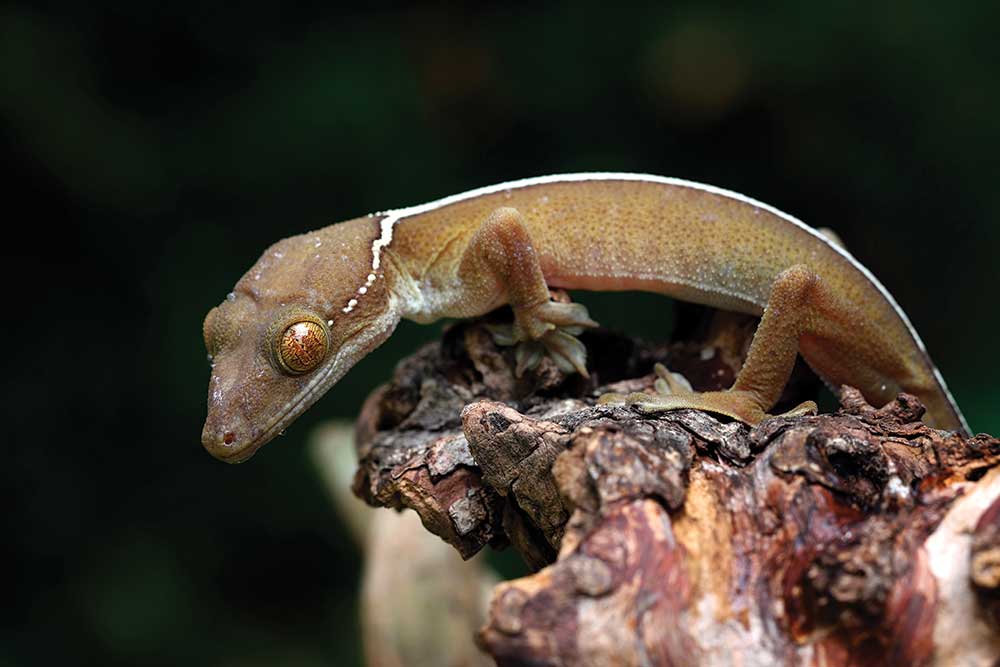As skunk geckos are an arboreal species, you will want to choose an enclosure that has more height rather than width.
With its dusky, gray-brown body and starkly contrasting white line down its back, it’s easy to see why the skunk gecko is a head turner. It is not a well known species and often earns excited reactions of “What kind of gecko is that?” My introduction to the species was less than ideal, as a wild-caught gecko was sent to the store I worked at. From that moment, I fell in love with the species. For anyone interested in keeping this beautiful reptile, here is what you will need to know.
Skunk Gecko Description
The skunk gecko (Gekko vittatus), originally described in 1782, can be found in the tropical rainforests of Indonesia, New Guinea, Palau and the Solomon Islands. They are an arboreal species that can be found in the canopies and understories of these rainforests. In addition to being called “skunk geckos,” they are also often referred to as lined geckos, white-lined geckos and palm geckos. The climate in their natural habitat is pretty consistent in terms of temperature and humidity. Humidity typically ranges from 70 percent to 90 percent year-round. Being an equatorial habitat, the temperature is also consistent, averaging between 86 to 90 degrees Fahrenheit (30 to 32.2 degrees Celsius) during the day and falling into the 70s degrees Fahrenheit (21.1 degrees Celsius) overnight. Being along the equator, the sun is out for around 12 hours all year. If you decide this species is for you, you should strive to duplicate these conditions, as many skunk geckos in the pet trade are, unfortunately, field collected and imported.
Gekko vittatus at a Glance
The skunk gecko has a grayish brown, tan or olive-green base color with a bold white stripe running from the back of each eye connecting at the back of the head to a single stripe that runs down its back. This white stripe is how it gets its name. It is a medium-sized, slender-bodied gecko that can reach 7 to 9 inches in length, including its tail. The tail has three bands around it with the same coloration as the body. The eyes have no eyelids and are a dark orange to amber color with slit pupils that help them see in the dark.
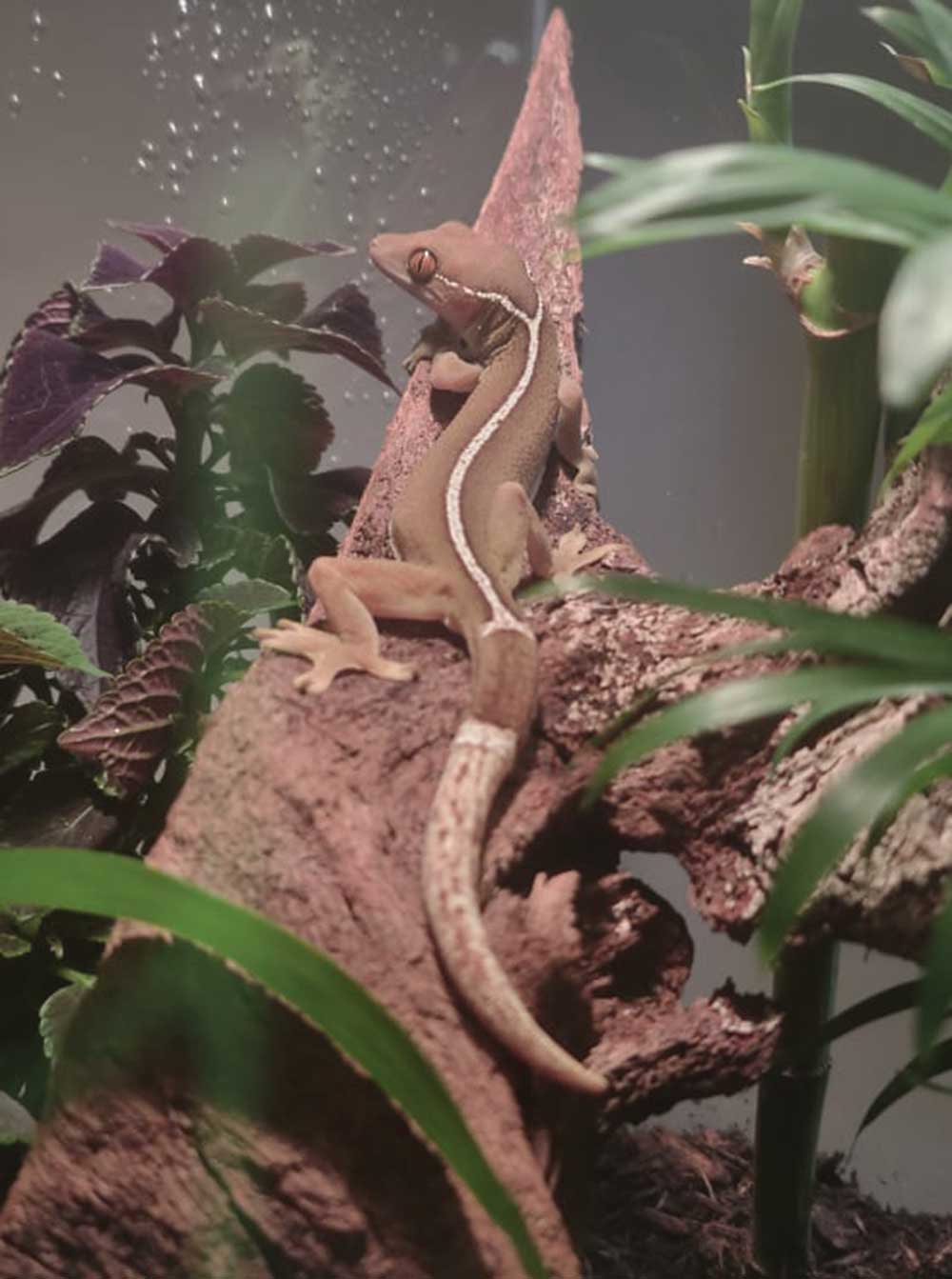
When it comes to handling, skunk geckos would prefer that you watch and do not touch them. Photo by Elizabeth Ralston.
Skunk geckos are “true geckos” and they are equipped with specialized toe pads that enable them to adhere to smooth surfaces. These specialized toe pads have microscopic hairs that are hook shaped and grab onto microscopic imperfections on smooth surfaces.
Choosing a Healthy Skunk Gecko
Since most skunk geckos are caught in their habitat and imported for the pet trade, it is important to choose a healthy specimen. The mouth and nostrils should be free of mucus, which could indicate a respiratory infection. They can also be prone to stomatitis, or mouth rot, and internal parasites. You can take a fecal sample to your local exotic vet to check for parasites. In the wild, these geckos typically live two to five years, but that extends drastically in captivity to 10 to 20 years, even for wild-caught individuals.
Check your gecko for superficial wounds on the body. Their skin is thin and prone to tearing easier than that of, say, a leopard gecko. Open wounds can lead to infection and should be checked. You should also check for stuck skin that was not removed during shedding. Difficulty shedding can be due to a variety of reasons, but it is usually linked to the conditions in which they are kept.
Skunk Gecko Enclosure Tips
As skunk geckos are an arboreal species, you will want to choose an enclosure that has more height rather than width. In my personal experience, be sure not sacrifice all of your width for height. I had my female in a converted 20-gallon long aquarium and rarely saw her. When I switched her to a 20-gallon hexagon enclosure, she really began to thrive. A mesh top will allow for ventilation and some ventilation on the sides or front will allow for more efficient airflow. Too much ventilation can cost you some of your required humidity, however. As with any other animal, a larger enclosure is always better. The wild is a vast place and these geckos can be quite active, given the space to move around.
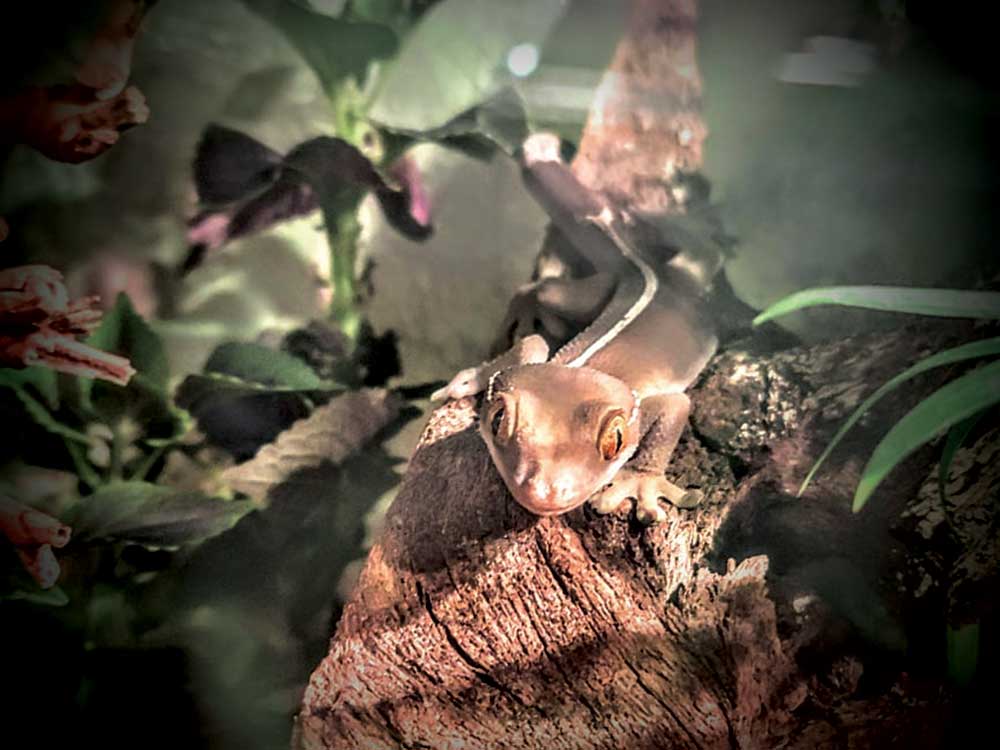
Lily stays in a bioactive enclosure. Because skunk geckos are largely arboreal, provide ample climbing structures for them. Photo by Elizabeth Ralston.
Choose a substrate that will hold some moisture, since these geckos prefer a more humid environment. Some options include peat moss, coconut fiber, coconut husk, or an organic, fertilizer-free topsoil. If you are going for a more basic setup, you could use newspaper or paper towels, but you will sacrifice humidity for simplicity.
Skunk geckos are a fairly private species and appreciate the ability to hide within their enclosure. By providing plenty of foliage, cork flats and driftwood, you can make your skunk gecko feel more secure in its habitat. You will find that no matter how you set up your enclosure, your skunk gecko will find an unexpected place to hide.
You should spot clean your enclosure every day or two, including the glass. These geckos are not opposed to defecating on the glass! If you have hard water, the mineral buildup on the glass can affect the gecko’s ability to stick to it. Use a non-toxic solution of one part vinegar to one part water to remove hard water mineral buildup.
The Benefits of Bioactive Enclosures
If you have been in the hobby of reptile keeping for a while, you may have heard the term “bioactive” thrown around. Bioactive enclosures pose certain benefits that a basic, minimalistic setup just does not.
For humid loving species, such as the skunk gecko, one of the big perks is that having live plants requires them to be watered. This can help maintain your humidity. You would need to choose appropriate plants, of course. Plants with broad leaves, like Pothos, and sturdy plants, like the snake plant, are perfect options.
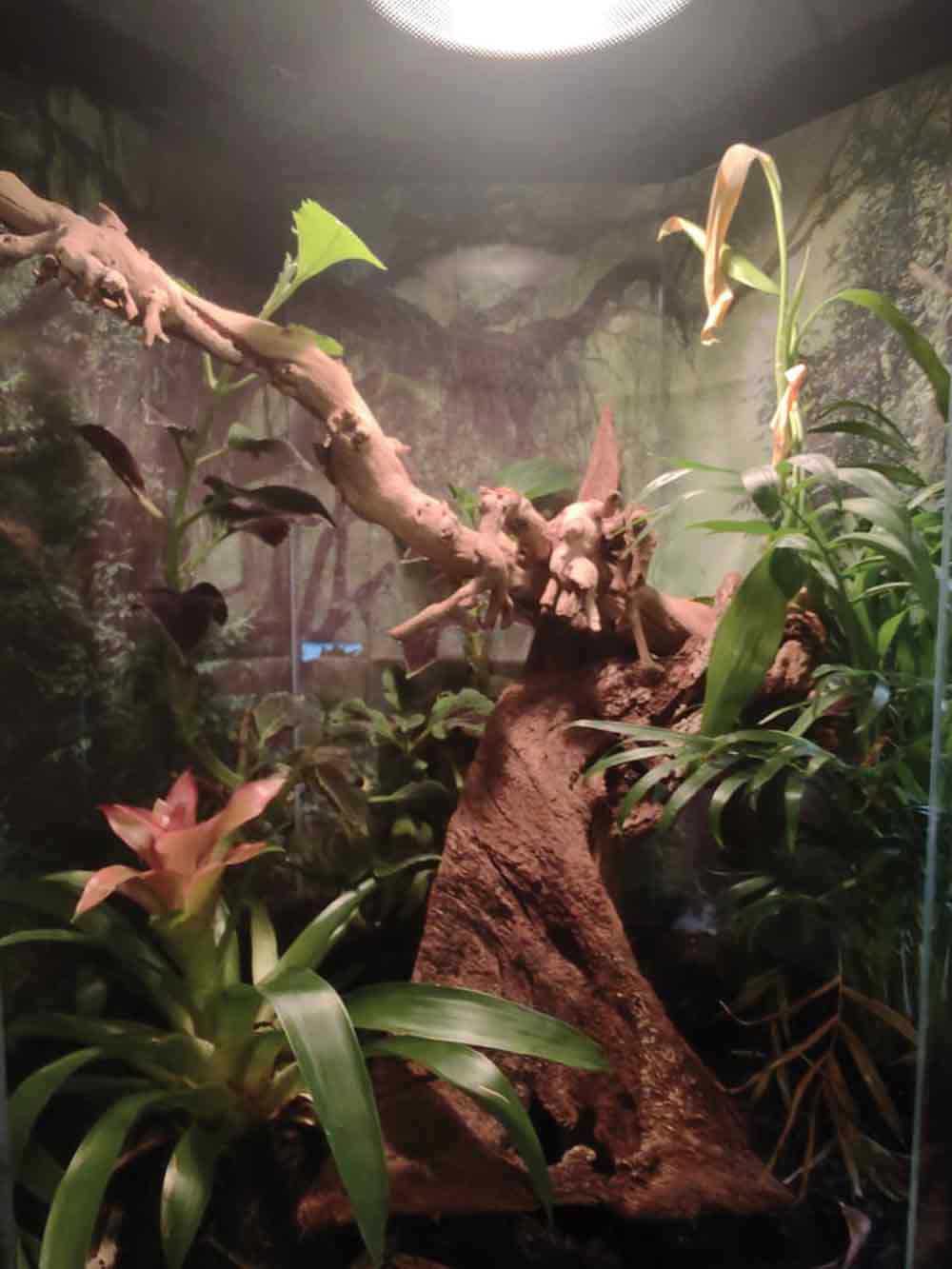
Bioactive enclosures have microfauna to help break down waste and decaying matter. These organisms are often referred to as a cleanup crew and can consist of springtails and isopods. Photo by Elizabeth Ralston.
Bioactive enclosures also have microfauna to help break down waste and decaying matter. These organisms are often referred to as a cleanup crew and can consist of springtails and various isopods.
How To Build A Bioactive Enclosure For Your Crested Gecko
8 Of The Most Popular Geckos For Reptilekeepers
These will also require some research to ensure you get species that will thrive in a bioactive environment. Live plants need light, which you should be providing to simulate a day and night cycle.
Ideas for bioactive habitats can be found all over the internet. It is an opportunity to get creative and provide enrichment for your gecko. Another benefit is that it is cost effective in the long run. You may need to spot clean from time to time and you will still need to wipe down the glass and provide food and water for your pet, but you will not need to empty the enclosure every month to clean it and risk your skunk gecko escaping during the process.
Skunk Gecko Humidity and Temperature
As previously mentioned, these geckos are from tropical rainforests, so they prefer a higher humidity range. Their humidity should be between 70 to 80 percent. Regular misting at least twice a day will help maintain this, along with proper substrate. As with other reptiles, the proper humidity is required to prevent illness and shedding problems. Just like with other tropical species, temperature is just as important as humidity. The ideal temperature range for skunk geckos is around 75 degrees Fahrenheit (23.9 degrees Celsius) at night to 85 to 90 degrees Fahrenheit (29.4 to 32.2 degrees Celsius) during the day. The temperature can be achieved by using a heat lamp above the cage and providing a top to bottom temperature gradient.
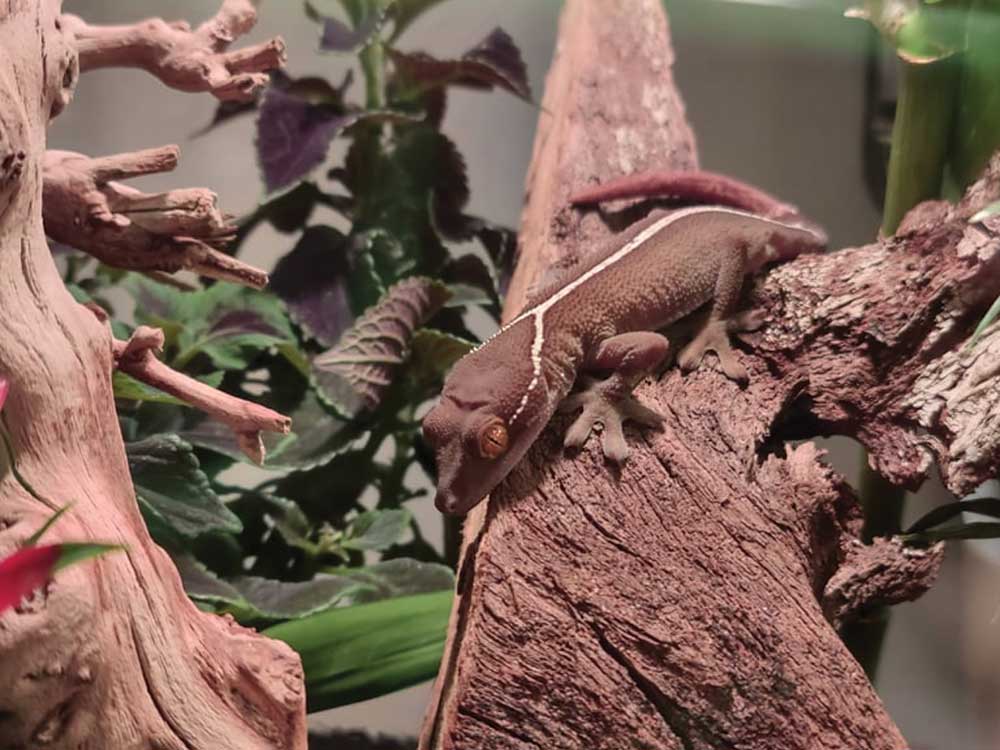
The skunk gecko is also known as the lined gecko due to the line that goes down its back. Photo by Elizabeth Ralston
Handling a Skunk Gecko
Skunk geckos are nocturnal, which means their activity will typically take place after you turn off the lights. They will climb around hunting whatever insects they may find. If you prefer late nights, you will certainly get some enjoyment out of seeing them catch their prey. When it comes to handling, this can be less enjoyable. Much like their close relative, the Tokay gecko (Gekko gecko), skunk geckos would prefer that you watch and do not touch them. Though less aggressive than their Tokay cousins, they may try to bite if you attempt to grab them. They even might make a high pitch barking sound! The skunk gecko can also drop its tail to escape, as with other lizards. Although the tail will grow back, it likely will not retain its original appearance.
These geckos are also very fast, so if it does get away from you, you will have a hard time trying to safely catch them. It is best to observe this species in its enclosure rather than risk an escape or injury.
Just like with any other reptile, these geckos shed their skin; and just like other geckos, they eat their shed. You can tell your skunk gecko is getting ready to shed because they get very pale and chalky in appearance. Within a few hours to a couple of days, you’ll have a fresh-looking gecko again.
Shedding is another reason the correct humidity is important. If they don’t shed properly, especially while growing, it can cause the loss of the tips of their toes and hinder their ability to properly cling to some surfaces. If you notice your gecko is getting ready to shed, you can bump your humidity up to around 90 percent to ensure that this happens smoothly.
Skunk Gecko Diet and Feeding
Skunk geckos prefer a diet of live insects. Crickets, dubia roaches, mealworms, black soldier fly larvae and, on rare occasions, wax worms can be provided. Insects should be dusted with a calcium supplement containing Vitamin D3. Black soldier fly larvae are already high in calcium, so they do not need to be dusted.
Feeder Insects — Crickets And Cockroaches
Their diet does not stop at insects, however! Skunk geckos also appreciate ripened fruit from time to time. You can mash bananas or other soft fruits or provide a formulated crested gecko diet as a treat for your skunk gecko. This should not be a staple in their diet. Bee pollen or a drop of honey can be added as well as a vitamin supplement to plain mashed fruit.
Since the skunk gecko is active at night, it is best to feed them in the evenings and remove any uneaten insects. Fruit-based foods should be removed within 24 hours to prevent mold and bacteria growth.
Skunk geckos get most of their moisture from the foods they eat, but they also will drink water drops off of their plants when you mist the cage. A shallow water dish should be provided inside the habitat for more constant water access. This can also help maintain the humidity between misting.
Breeding Skunk Geckos
There are some things to be known about the breeding of these geckos. First, it helps to be able to determine the sex of your gecko. Males have a hemipenal bulge at the base of the tail on either side. While these are not as distinct as they would be on a crested gecko, they should be visible. Another way to tell is by looking for femoral pores. These are located near the gecko’s vent between the back legs.
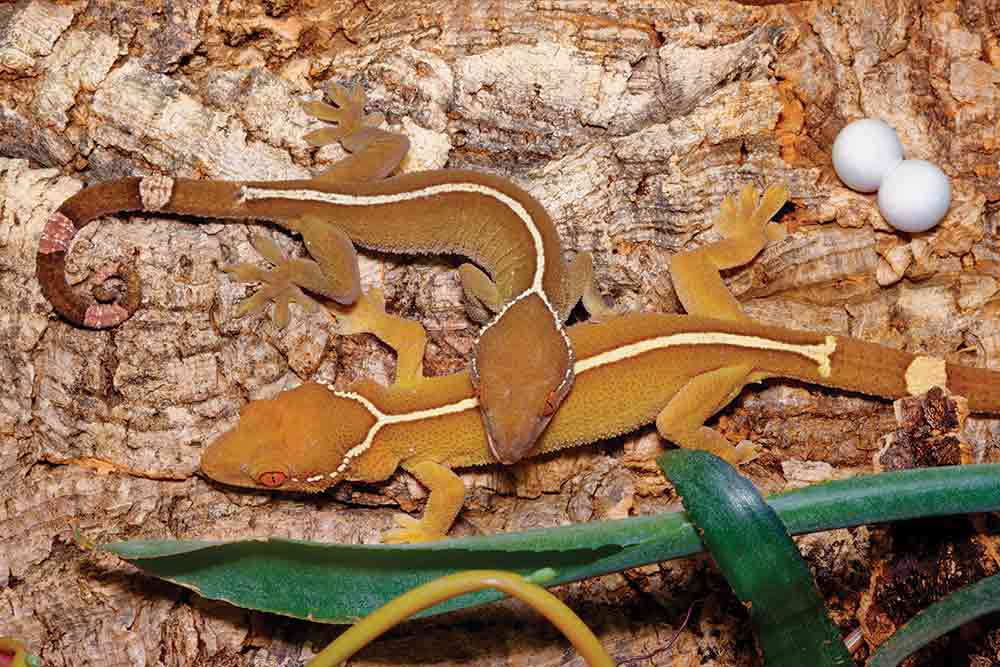
A mating pair of skunk geckos with two eggs. Photo by Valt Ahyppo/Shutterstock.
They will resemble small spots on each scale in a row or V-shape. Just like many other arboreal geckos, skunk geckos are egg gluers. This means that they tend to “fix” their eggs to a surface. In captivity, this can be a decoration or the glass walls. Females will lay one or two eggs at a time. Some females will lay eggs without a mate, but they will be infertile. If your gecko does happen to lay eggs, you should provide additional calcium, as forming and laying eggs can deplete the female’s calcium stores.
If you happen to have a pair of geckos that provide fertile eggs, it is best to leave the eggs attached to whatever the female has attached them to in order to reduce the risk of breaking the eggs. Parents, particularly the female, may protect the eggs and can vocalize or try to bite if you disturb them. If you have fertile eggs and they hatch in your adults’ enclosure, you should remove the babies. Skunk geckos can be territorial and can attack the babies and cause injury.
Where to Buy Skunk Geckos
Skunk geckos are not a common species in the reptile hobby, which can make them tricky to find. Expos are one place to look. You may also have some luck finding someone who breeds them in captivity. They do not tend to be very expensive if you do manage to come across this stunning reptile. If you do happen to see one in a pet store, it is most likely wild-caught.
Conclusion
There is not a lot of information out there on this species. There is little captive breeding and no one seems to be sharing the breeding information. There is not even much information about this species in the wild. For all the people that ask me about my own skunk gecko, it is surprising that there are not more in the hobby. Hopefully we can bring some attention to this species and shed some more light on this beautiful reptile in the future and learn more about them.
Elizabeth Ralston acquired her skunk gecko, Lily from the store she worked at and fell in love with the species.

